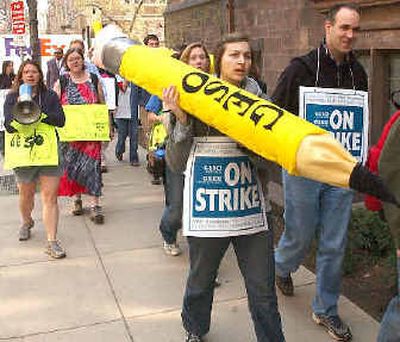Unions must change tactics to sign up the brainy bunch

NEW HAVEN, Conn. — Union organizers at Yale University know it’s hard to generate sympathy for Ivy League graduate students who are paid up to $25,000 a year to teach.
It’s the same story in Washington, where a union is courting Microsoft employees, and in New York, where organizers are trying to drum up support at IBM.
With American manufacturing jobs disappearing, many union leaders say they must organize high-tech workers and academics to survive. But organizers are finding that to rally a white-collar work force, they can’t follow the 20th-century story line pitting workers and their numbers against businessmen and their money.
The union rallying the Yale student teachers, UNITE/HERE, built its reputation organizing garment workers, mostly women and immigrants who endured long hours and meager pay. Yalies with the promise of bright futures don’t have the same self-image — or public image.
Organizers often hear white-collar workers have a good enough deal and shouldn’t complain, said Marcus Courtney, president of the Washington Alliance of Technology Workers.
Today’s union drives require organizers to change the way the public views white-collar workers and how the employees view themselves.
Many people see unions as something that truck drivers and telephone linesmen need, but software engineers do not. Increasingly, union leaders find that workers feel that way, too.
“The modern white-collar work force in America brings a tremendous amount of skepticism when it comes to organized labor, and it’s an obstacle we face every day,” said Courtney, a former contract worker for Microsoft. White-collar workers believe that an education and a skill level gives negotiating power, so collective bargaining with employers is no longer necessary, he said.
Unions typically organize a workplace by persuading employees to sign membership cards and sometimes to commit to paying dues. Once a majority of workers have signed cards, labor leaders can ask the company to voluntarily recognize the union, or it can ask the National Labor Relations Board to hold an election.
With fewer than 200 of IBM’s 133,000 U.S. workers paying dues last year, the Alliance at IBM, a New York-based subsidiary of the Communication Workers of America, could not force recognition or win an election.
It hasn’t given up; it’s talking to workers about jobs being outsourced overseas and about declining pension values. In Silicon Valley and Washington, unions talk about the growing use of part-time contract work. At video game companies, it’s about grueling hours.
At Yale, organizers face a battle to win recognition. The National Labor Relations Board ruled last year that teaching assistants at private colleges are not workers and cannot form a union. The only way to win recognition would be for administrators to voluntarily grant it, something they have refused to do.
Despite those obstacles, teaching assistants went on strike last month, picketing to publicize their issues. They talked about how universities increasingly rely on them to teach, tutor and grade undergraduates. The students demanded better medical coverage for their families and a way to raise work concerns with their bosses.
“We’re at the forefront of organizing the new economy,” said Lee Conrad, national coordinator for the Alliance at IBM. “We’re bringing up the issues that are important.”
The union brass also needs to persuade their blue-collar base that high-tech workers face the same issues — job exportation, increased workloads and the rising cost of health care — as people in the service industries.
That, too, has been a struggle, Courtney said, as some veteran union bosses stick to the idea that the only workers who really need a union are the low-wage laborers.
“In the labor movement, we can’t afford to pick and choose,” Courtney said. “It’s not just about narrow issues like how much you get paid. It’s about broader political issues. It’s about fairness.”
With 13 million members, the AFL-CIO is the country’s largest labor union federation. It took in $184 million last year in dues, investments and other income and remains a potent force in labor and politics. But membership has declined by nearly 200,000 in the past four years and receipts are down $11 million.
As they fight the exportation of manufacturing jobs, major unions are investing more money in groups organizing white-collar workers. The Communication Workers of America helped WashTech, the group trying to organize at Microsoft, raise more than $442,000 last year despite having fewer than 500 dues-paying workers.
“I think it’s critically important, not just for the labor movement but for the country, that we figure out how to unionize those jobs,” said John Wilhelm, president of UNITE/HERE.
That’s why union leaders haven’t given up on Yale where, despite a decade of organization efforts, there were no dues-paying graduate students last year.
“If highly educated students at one of the world’s most prestigious institutions all of a sudden collectively decide, ‘We need an organized voice,’ what are they figuring out that other workers need to figure out?” Courtney said. “What got them to that point. That’s a key thing. That can inspire the labor movement.”